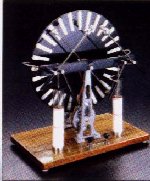|
There are two good static electricity
generators that are used in many schools and
laboratories. One of them is the older Wimshurst
Electrostatic Generator and the other is the newer Van
de Graaff Generator. Both are capable of generating high
power static electricity, sufficient to shoot sparks,
cause the hair on your head to rise and light
fluorescent bulbs.
Questions your may have are:
-
How does the Wimshurst Electrostatic
Generator work?
-
How does the Van de Graaff Generator
work?
-
What can you do with those devices?
Wimshurst generator
The Wimshurst electrostatic generator
was invented in the 1880s. The modern version consists
of two plastic discs that are rotated in opposite
directions by a hand-crank and drive belt mechanism.

Wimshurst
Electrostatic Generator
The way it works is that a number of
metal foil sectors are cemented onto two discs. As the
discs turn, each metal foil sector accumulates the
charges through contact with brushes on bars near the
front and back of the discs. Two additional pairs of
brushes collect the accumulated charges and transmit
them to the storage capacitor, such as a Leyden jar
The brushes also are connected to spark
gap electrodes. As the discs revolve, a high voltage
spark can jump between the electrodes if they are
gradually brought together.
The Wimshurst electrostatic generator
can generate up to 75,000 volts. Since the current is
very low, there is little danger from the high voltage,
but yet it is effective for creating sparks and
performing interesting static electricity experiments.
Van de Graaff generator
The Van de Graaff generator can develop
potential energy of as high as 400,000 volts, and it
will develop sparks up to 15 inches (38 centimeters) in
length.
It is relatively safe to use though,
since the current is only 10 microamps (10/1,000,000
amps). This is because electrical power equals the
voltage times the amperage. 400,000 volts times 10
microamps equal only 4 watts�the energy to light a
flashlight bulb.

Van de Graaff Generator with a hand
stuck to it
The Van de Graaff generator is powered
by a high speed electric motor. It has a belt running on
two pulleys. The lower pulley is made of an insulating
material and the upper pulley is made of metal. There is
a grounded comb close to the belt in front of the lower
pulley, and another inside the terminal, close to the
belt in front of the upper pulley, connected to the
terminal.
Adhesion between the belt and the lower
pulley charges the pulley, and it attracts opposite
charges to the outer surface of the belt from the
grounded comb. The belt then transports these charges to
the terminal, where they are collected by the upper comb
and transferred to the terminal. The shielding provided
by the terminal allows the continuation of the process
even if the terminal is already strongly charged. The
high speed of the belt, along with the large discharge
electrode, allows the continuous buildup of charges and
great voltages to be achieved.
The Van de Graaff generator in the
picture is about 35 inches (90 cm) high. Some scientific
laboratories have such generators several stories high.
They can develop sparks that go all the way across the
room. But still that doesn't compare to the power of
lightning, which can be several miles long.
When a person puts his or her hand on
the globe of the Van de Graaff generator, the person's
hair will stand on end. This is because the static
charges collect on the hair and like charge repel, thus
repelling the hairs from each other.
When you take a fluorescent bulb and
bring it near a Van de Graaff generator, the charges
excite the atoms inside the bulb, cause it to glow--even
if the bulb is not plugged in.
The Wimshurst and Van de Graaff
generators are two good sources for generating static
electricity. Both use high-speed nonconductors and
brushes to create the static electricity. They can
provide extremely high voltages, but since the current
or amperage is very low, they are still safe to use. |